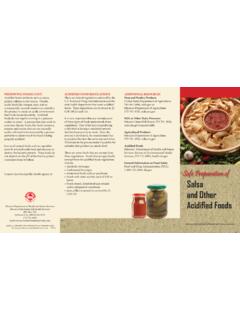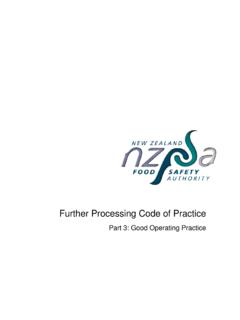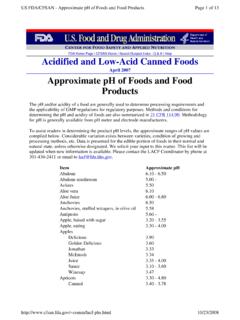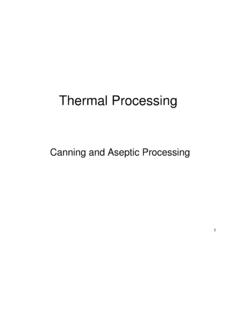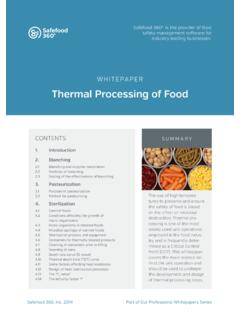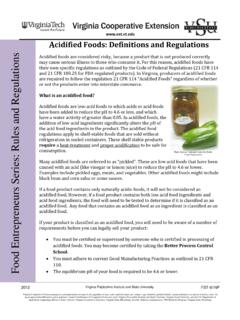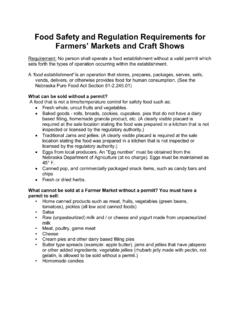Transcription of CODE OF HYGIENIC PRACTICE FOR LOW AND ACIDIFIED LOW …
1 Adopted 1979. Revisions 1989 and 1993. Editorial corrections 2011. CODE OF HYGIENIC PRACTICE FOR LOW AND ACIDIFIED LOW acid canned FOODS1 (CAC/RCP 23-1979) CONTENTS PAGE SECTION I: SCOPE .. 2 SECTION II: 2 SECTION III: HYGIENE REQUIREMENTS IN PRODUCTION/HARVESTING AREA .. 4 SECTION IV: ESTABLISHMENT: DESIGN AND FACILITIES .. 6 SECTION V: ESTABLISHMENT: HYGIENE REQUIREMENTS.
2 10 SECTION VI: PERSONNEL HYGIENE AND HEALTH 12 SECTION VII: ESTABLISHMENT: HYGIENIC PROCESSING REQUIREMENTS .. 14 SECTION VIII: QUALITY ASSURANCE .. 41 SECTION IX: STORAGE AND TRANSPORTATION OF FINISHED 43 SECTION X: LABORATORY CONTROL PROCEDURES .. 44 SECTION XI: END-PRODUCT 44 APPENDIX I: ACIDIFIED LOW- acid canned 46 APPENDIX II: ANALYTICAL METHODOLOGY FOR pH MEASUREMENT .. 58 APPENDIX III: REFERENCES FOR TEAR-DOWN EVALUATION OF A DOUBLE 63 APPENDIX IV: GUIDELINES FOR THE SALVAGE OF canned FOODS EXPOSED TO ADVERSE CONDITIONS.
3 64 APPENDIX V: GUIDELINE PROCEDURES TO ESTABLISH MICROBIOLOGICAL CAUSES OF SPOILAGE IN LOW- acid AND ACIDIFIED LOW- acid canned 72 1 The application of this Code requires knowledge and experience of canning technology. It is not intended to be used as a complete operating manual. It primarily addresses HYGIENIC critical control points. It should be used in conjunction with appropriate texts and manuals on the subject. CAC/RCP 23-1979 Page 2 of 85 CODE OF HYGIENIC PRACTICE FOR LOW- acid AND ACIDIFIED LOW- acid canned FOODS CAC/RCP 23-1979 SECTION I - SCOPE 1.
4 This Code of PRACTICE is concerned with the canning and heat processing of low- acid and ACIDIFIED low- acid foods as defined in this Code, packed in hermetically sealed containers. It does not apply to foods in hermetically sealed containers which require refrigeration. Annex I applies specifically to ACIDIFIED low- acid foods. SECTION II - DEFINITIONS 2. For the purposes of this Code: " acid food " means a food that has a natural pH of or below. " ACIDIFIED low- acid food " means a food which has been treated so as to attain an equilibrium pH of or lower after heat processing.
5 "Aseptic processing and packaging" means the filling of a commercially sterile product into sterilized containers followed by hermetical sealing with a sterilized closure in an atmosphere free from microorganisms. "Bleeders" (Bleeds) means small orifices through which steam and other gases escape from the retort throughout the entire heat process. " canned food " means commercially sterile food in hermetically sealed containers. "Cleaning" means the removal of food residues, dirt, grease or other objectionable material.
6 "Code lot" means all product produced during a period of time identified by a specific container code mark. "Coming-up-time" means the time, including venting time, which elapses between the introduction of the heating medium into the closed retort and the time when the temperature in the retort reaches the required sterilization temperatures. "Commercial sterility of thermally processed food " means the condition achieved by application of heat, sufficient, alone or in combination with other appropriate treatments, to render the food free from microorganisms capable of growing in the food at normal non-refrigerated conditions at which the food is likely to be held during distribution and storage.
7 "Commercial sterility of equipment and containers used for aseptic processing and packaging of food " means the condition achieved and maintained by application of heat, or other appropriate treatment, which renders such equipment and containers free from microorganisms capable of growing in the food at temperatures at which the food is likely to be held during distribution and storage. CAC/RCP 23-1979 Page 3 of 85 "Disinfection" means the reduction, without adversely affecting the food , by means of hygienically satisfactory chemical agents and/or physical methods, of the number of microorganisms to a level that will not lead to harmful contamination of food .
8 "Equilibrium pH" is the pH of the macerated heat processed food product. "Flame sterilizer" means an apparatus in which hermetically sealed containers of foods are agitated at atmospheric pressure, by either continuous, discontinuous or reciprocating movement, over gas flames to achieve commercial sterility of foods. "Heating curve" means a graphical representation of the rate of temperature change in the food throughout the heat process; this is usually plotted on semi-log graph paper so that the temperature on an inverted log scale is plotted against time on a linear scale.
9 "Broken heating curve" means a heating curve which shows a distinct change in the rate of heat transfer such that the curve may be represented by two or more distinct straight lines. "Simple heating curve" means a heating curve which approximates a straight line. "Headspace" means the volume in a container not occupied by the food . "Holding time", see sterilization time. "Incubation tests" means tests in which the heat processed product is kept at a specific temperature for a specified period of time in order to determine if outgrowth of microorganisms occurs under these conditions.
10 "Initial temperature" means the temperature of the contents of the coldest container to be processed at the time the sterilizing cycle begins, as specified in the scheduled process. "Low- acid food " means any food , other than alcoholic beverages, where any component has a pH value greater than and a water activity greater than "Potable water" means water fit for human consumption. Standards of potability should be no less strict than those contained in the latest edition of the "International Standards for Drinking Water", World Health Organization.










